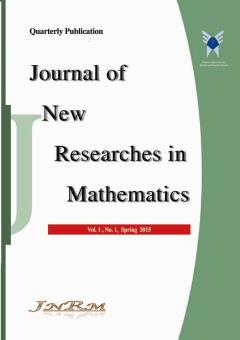مدلسازی تصفیه پساب های صنعتی بر پایه شبکه عصبی مصنوعی و مدل آماری رگرسیون لجستیک
Subject Areas : Numeric Analyze
Seyedrahim Saneifard
1
*
![]() ,
F. Ghanbary
2
,
A. Jafarian
3
,
F. Ghanbary
2
,
A. Jafarian
3
1 - Department of Mathematics, Islamic Azad University, Urmia, Iran.
2 - Department of Chemistry, Mahabd Branch, Islamic Azad University, Mahabad, Iran.
3 - Department of Mathematics, Urmia Branch, Islamic Azad University, Urmia, Iran.
Keywords: مدل هوشمند ترکیبی, رگرسیون لجستیک, شبکه عصبی مصنوعی, مالاشیت سبز,
Abstract :
One of the most important and fundamental factors in the life of living things is water. Therefore, water pollution is a major environmental problem and prevent water pollution and providing smart methods for water treatment is so important. Equipping engineering sciences with intelligent tools and artificial intelligence in the diagnose quality of wastewater treatments can reduce the errors of the methods. This paper presents a simple and hybrid neural network with statistical logistic regression method for modelling of the output quality of wastewater treatment. The proposed intelligent method plays an important role in the quality of wastewater treatment and can be used by artificial intelligence researchers and environmental engineers. Comparison of the predicted results by simple neural network and hybrid one showed that the efficiency of the hybrid model and it is suitable for our purpose. results of research proved that the new method has the highest efficiency with minimum errors.
[1] M. A., BEHNAJADY, N. MODIRSHAHLA and F. GHANBARY, “A kinetic model for the decolorization of C.I. Acid Yellow 23 by Fenton process,” J. of Hazar. Mate., vol.148, no. 3, pp. 98-102, 2007.
[2] N. DANESHVAR, A. R. KHATAEE and N. JAFARZADEH,”The use of artificial neural networks (ANN) for modeling of decolorization of textile dye solution containing C. I. Basic Yellow 28 by electrocoagulation process,” J. of Hazar. Mate., vol 137, no. 4,pp. 1788-1795, 2006.
[3] F. GHANBARY and A. JAFARIAN, “Polyaniline/wheat Husk Ash Nanocomposite Preparation and Modeling Its Removal Activity with an Artificial Neural Network,” Chiang Mai J. of Science, vol. 42, no. 9, pp. 1-12, 2015.
[4] J. WAN, M. HUANG, Y. MA and X.SUN, ”Prediction of effluent quality of a paper mill wastewater treatment using an adaptive network-based fuzzy inference system,” App. Soft Comp., vol. 11, no. 3, pp. 323-34, 2011.
[5] S. POMMIER, D. CHENU, M. QUINTARD and X. LEFEBVRE, “A logistic model for the prediction of the influence of water on the solid waste methanization in landfills,” Biotech. and bioeng., vol. 97, no. 6, pp. 473-482, 2007.
[6] I. MICHAEL, A. PANAGI, L. A. IOANNOU and Z. FRONTISTIS, ”Utilizing solar energy for the purification of olive mill wastewater using a pilot-scale photocatalytic reactor after coagulation-flocculation,” J. of Water res.,vol. 60, no. 7, pp. 28-40, 2014.
[7] H. HONGGUI, and Y. LI, “A fuzzy neural network approach for online fault detection in waste water treatment process,” Comp. & Elec. Eng., vol.40, no.12, pp. 2216-2226, 2014.
[8] M. S. NASR, M. A. MOUSTAFA, H. A. SEIF and G. E. KOBROSY, “Application of Artificial Neural Network (ANN) for the prediction of EL-AGAMY wastewater treatment plant performance-EGYPT,” Alex. Eng. J., vol. 51, no.25, pp. 37-43, 2012.
[9] T. R. NEELAKANTAN and G. M. BRION, “Neural network modelling of Cryptosporidium and Giardia concentrations in the Delaware River,” Water Sci. & Tech. vol. 43, no. 23, pp. 125-132, 2001.
[10] U. GOVINDARAJ and S. RAO, “Artificial neural networks in hydrologic applications,” J. of Hydro. Eng., vol. 52, no. 42, pp. 124-137, 2000.
[11] H. R. MAIER and G. C. DANDY, “Neural networks for the prediction and forecasting of water resources variables: a review of modelling issues and applications,” Env. modelling & soft., vol. 15, no. 12, pp. 101-124, 2000.
[12] J. ZURADA, “Introduction to Artificial Neural Systems,” West Publishing, 1992.
[13] S. HAYKIN, “Neural networks:a comprehensive foundation,” Prentice Hall., New Jersey, USA, 1999.
[14] Y. X. ZHANG, “Artificial neural networks based on principal component analysis input selection for clinical pattern recognition analysis,” Talanta, vol.73, no.8, pp. 68-75, 2007.
[15] F. GHANBARY, N. MODIRSHAHLA, M. KHOSRAVI and M. A. BEHNAJADY, “Synthesis of TiO2nanoparticles in different thermal conditions and modeling its photocatalytic activity with artificial neural network,” j. of Env. sciences, vol. 24, no. 21, pp. 750-756, 2012.

